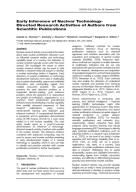Details
- Identification
- ISSN: 1977-5296, DOI: 10.3011/ESARDA.IJNSNP.2024.2
- Publication date
- 8 May 2024
- Author
- Joint Research Centre
Description
Volume: 66, December 2024, pages 7-27
Authors: Dennis G. Thomas, Zachary J. Weems, Richard E. Overstreet, Benjamin A. Wilson
Pacific Northwest National Laboratory, 902 Battelle Blvd, Richland, WA, USA, 99354
Abstract: Nuclear research articles can provide information about early nuclear proliferation indicators such as influential research entities and technology capability levels of a country, but detection of nuclear activities typically occurs after they have started. We investigate the extent to which nuclear research articles can be used to infer whether a research entity will acquire or develop a nuclear technology before it happens. Early detection of nuclear proliferation or technology development indicators from data is challenging due to partial observability, sparse and unlabeled information, and confounding signals from multiple concurrent activities. This paper presents the early detection problem as a sequential decision-making, goal inference problem, where the objective is to characterize and predict an individual’s, organization’s, or a country’s intent (unobserved goal-directed behavior) towards developing a nuclear capability from partially observed sequences of their research publications, using inverse reinforcement learning and Bayesian goal inference methods. A computational framework is presented, and its application demonstrated using 29,196 Scopus records for a case study related to a civil nuclear capability. The case study results serve as a proof-of-concept demonstration for inference of technology-directed research activity of authors who publish in the nuclear domain. The inference method, combined with advanced computing, may be used to assess and monitor activities pertaining to early developmental stages of a nuclear technology or capability, which in turn can help to identify and prioritize activities with nuclear proliferation potential for further investigation.
Keywords: Nuclear, Reinforcement, Learning, Bayesian, Inference, AI
Reference guideline:
Thomas, D.G, Weems, Z.J., Overstreet, R.E., and Wilson, B.A. (2024, December). Early Inference of Nuclear Technology-Directed Research Activities of Authors from Scientific Publications, ESARDA Bulletin - The International Journal of Nuclear Safeguards and Non-proliferation, 66, 7-27. https://doi.org/10.3011/ESARDA.IJNSNP.2024.2

